Hamza Djelouat
Adaptive and Self-Tuning SBL with Total Variation Priors for Block-Sparse Signal Recovery
Mar 12, 2025

Abstract:This letter addresses the problem of estimating block sparse signal with unknown group partitions in a multiple measurement vector (MMV) setup. We propose a Bayesian framework by applying an adaptive total variation (TV) penalty on the hyper-parameter space of the sparse signal. The main contributions are two-fold. 1) We extend the TV penalty beyond the immediate neighbor, thus enabling better capture of the signal structure. 2) A dynamic framework is provided to learn the penalty parameter for regularization. It is based on the statistical dependencies between the entries of tentative blocks, thus eliminating the need for fine-tuning. The superior performance of the proposed method is empirically demonstrated by extensive computer simulations with the state-of-art benchmarks. The proposed solution exhibits both excellent performance and robustness against sparsity model mismatch.
Low-Complexity Near-Field Channel Estimation for Hybrid RIS Assisted Systems
Apr 30, 2024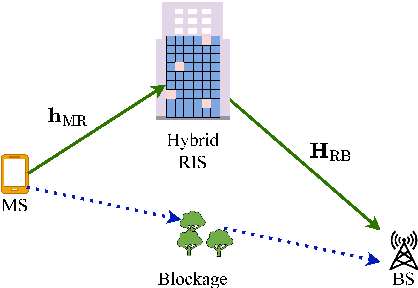
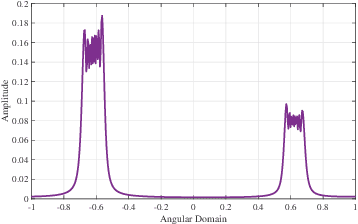
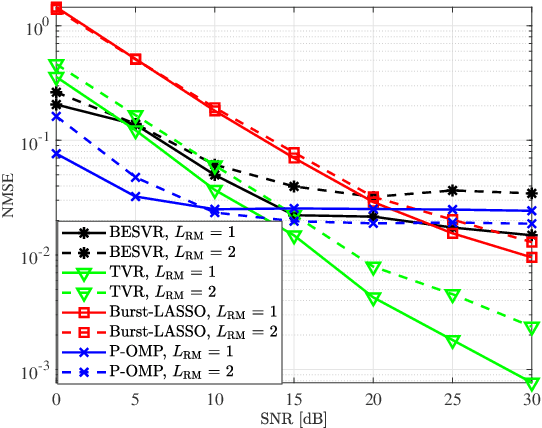
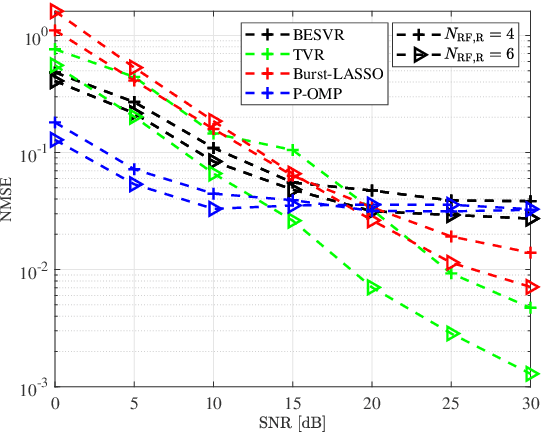
Abstract:We investigate the channel estimation (CE) problem for hybrid RIS assisted systems and focus on the near-field (NF) regime. Different from their far-field counterparts, NF channels possess a block-sparsity property, which is leveraged in the two developed CE algorithms: (i) boundary estimation and sub-vector recovery (BESVR) and (ii) linear total variation regularization (TVR). In addition, we adopt the alternating direction method of multipliers to reduce their computational complexity. Numerical results show that the linear TVR algorithm outperforms the chosen baseline schemes in terms of normalized mean square error in the high signal-to-noise ratio regime while the BESVR algorithm achieves comparable performance to the baseline schemes but with the added advantage of minimal CPU time.
Device Detection and Channel Estimation in MTC with Correlated Activity Pattern
Oct 23, 2023
Abstract:This paper provides a solution for the activity detection and channel estimation problem in grant-free access with correlated device activity patterns. In particular, we consider a machine-type communications (MTC) network operating in event-triggered traffic mode, where the devices are distributed over clusters with an activity behaviour that exhibits both intra-cluster and inner-cluster sparsity patterns. Furthermore, to model the network's intra-cluster and inner-cluster sparsity, we propose a structured sparsity-inducing spike-and-slab prior which provides a flexible approach to encode the prior information about the correlated sparse activity pattern. Furthermore, we drive a Bayesian inference scheme based on the expectation propagation (EP) framework to solve the JUICE problem. Numerical results highlight the significant gains obtained by the proposed structured sparsity-inducing spike-and-slab prior in terms of both user identification accuracy and channel estimation performance.
Hierarchical MTC User Activity Detection and Channel Estimation with Unknown Spatial Covariance
Oct 16, 2023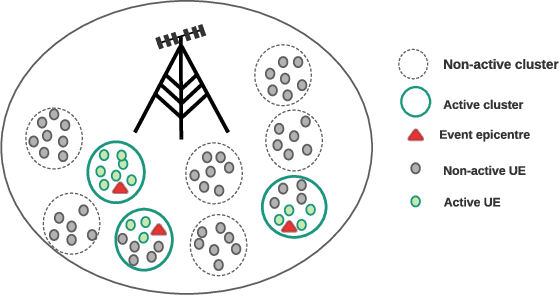
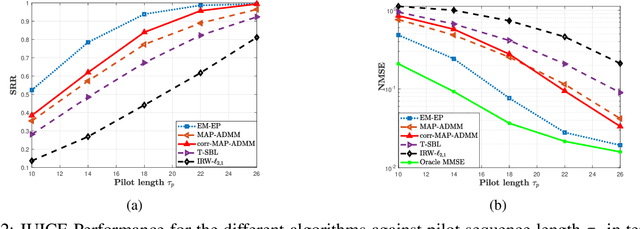

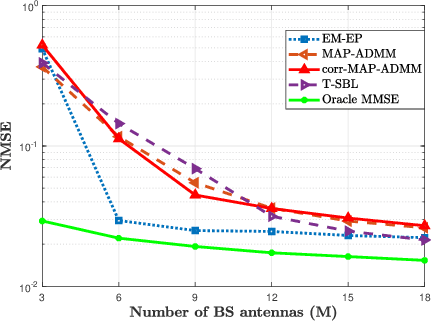
Abstract:This paper addresses the joint user identification and channel estimation (JUICE) problem in machine-type communications under the practical spatially correlated channels model with unknown covariance matrices. Furthermore, we consider an MTC network with hierarchical user activity patterns following an event-triggered traffic mode. Therein the users are distributed over clusters with a structured sporadic activity behaviour that exhibits both cluster-level and intra-cluster sparsity patterns. To solve the JUICE problem, we first leverage the concept of strong priors and propose a hierarchical-sparsity-inducing spike-and-slab prior to model the structured sparse activity pattern. Subsequently, we derive a Bayesian inference scheme by coupling the expectation propagation (EP) algorithm with the expectation maximization (EM) framework. Second, we reformulate the JUICE as a maximum a posteriori (MAP) estimation problem and propose a computationally-efficient solution based on the alternating direction method of multipliers (ADMM). More precisely, we relax the strong spike-and-slab prior with a cluster-sparsity-promoting prior based on the long-sum penalty. We then derive an ADMM algorithm that solves the MAP problem through a sequence of closed-form updates. Numerical results highlight the significant performance significant gains obtained by the proposed algorithms, as well as their robustness against various assumptions on the users sparse activity behaviour.
Joint Activity Detection and Channel Estimation for Clustered Massive Machine Type Communications
May 04, 2023Abstract:Compressed sensing multi-user detection (CS-MUD) algorithms play a key role in optimizing grant-free (GF) non-orthogonal multiple access (NOMA) for massive machine-type communications (mMTC). However, current CS-MUD algorithms cannot be efficiently parallelized, which results in computationally expensive implementations of joint activity detection and channel estimation (JADCE) as the number of deployed machine-type devices (MTDs) increases. To address this, the present work proposes novel JADCE algorithms that can be applied in parallel for different clusters of MTDs by exploiting the structure of the pilot sequences. These are the approximation error method (AEM)-alternating direction method of multipliers (ADMM) and AEM-sparse Bayesian learning (SBL). Results presented in terms of the normalized mean square error and the probability of miss detection evince comparable performance to the conventional algorithms. However, both AEM-ADMM and AEM-SBL algorithms have significantly reduced computational complexity and run-times, thus, increasing network scalability.
Joint Estimation of Clustered User Activity and Correlated Channels with Unknown Covariance in mMTC
Nov 30, 2022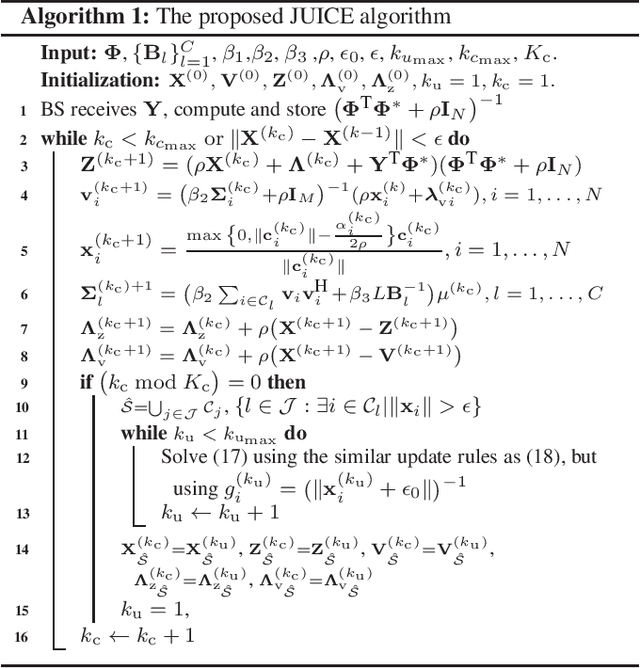
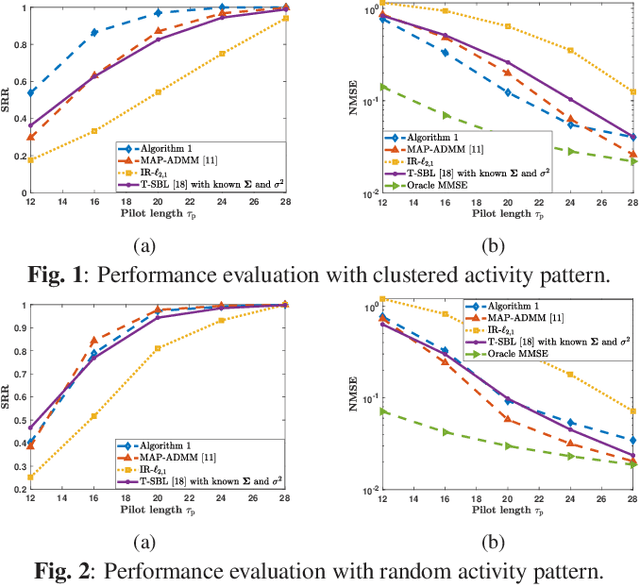
Abstract:This paper considers joint user identification and channel estimation (JUICE) in grant-free access with a \emph{clustered} user activity pattern. In particular, we address the JUICE in massive machine-type communications (mMTC) network under correlated Rayleigh fading channels with unknown channel covariance matrices. We formulate the JUICE problem as a maximum \emph{a posteriori} probability (MAP) problem with properly chosen priors to incorporate the partial knowledge of the UEs' clustered activity and the unknown covariance matrices. We derive a computationally-efficient algorithm based on alternating direction method of multipliers (ADMM) to solve the MAP problem iteratively via a sequence of closed-form updates. Numerical results highlight the significant improvements brought by the proposed approach in terms of channel estimation and activity detection performances for clustered user activity patterns.
Joint Coherent and Non-Coherent Detection and Decoding Techniques for Heterogeneous Networks
Sep 27, 2022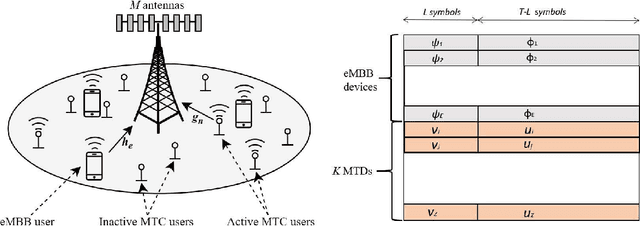
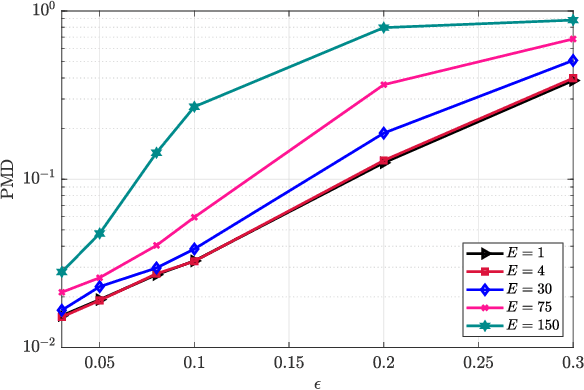
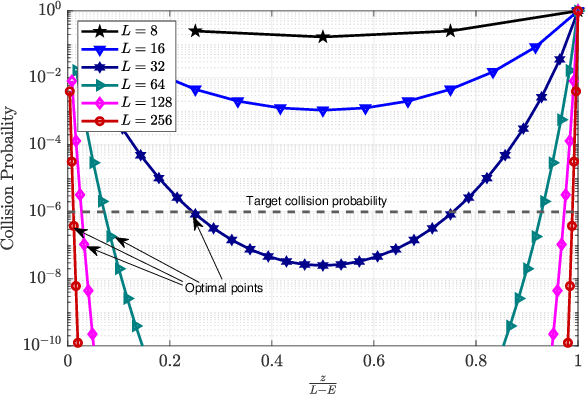
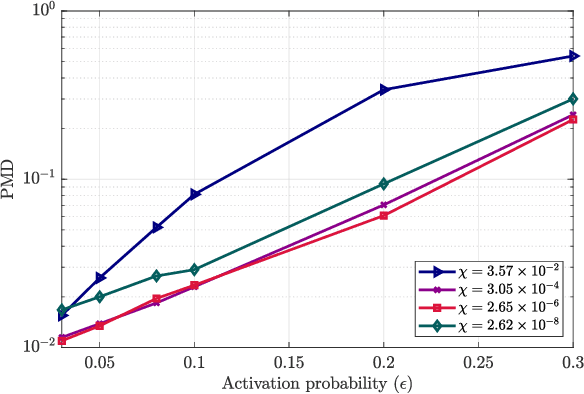
Abstract:Cellular networks that are traditionally designed for human-type communication (HTC) have the potential to provide cost effective connectivity to machine-type communication (MTC). However, MTC is characterized by unprecedented traffic in cellular networks, thus posing a challenge to its successful incorporation. In this work, we propose a unified framework for amicable coexistence of MTC and HTC. We consider a heterogeneous network where machine-type devices coexist with enhanced mobile broadband (eMBB) devices and propose transceiver techniques that promote efficient signal recovery from these devices. For this, we present an eMBB pilot and MTC data generation strategy that facilitates joint coherent decoding of eMBB data and non-coherent decoding of MTC data. Furthermore, we assess the feasibility of coexistence using receiver operating characteristics, outage probability, and normalized mean square error (NMSE). Our numerical results reveal that a harmonious coexistence of the heterogeneous services can be achieved with properly configured average signal-to-noise ratios and pilot length.
User Activity Detection and Channel Estimation of Spatially Correlated Channels via AMP in Massive MTC
Dec 08, 2021
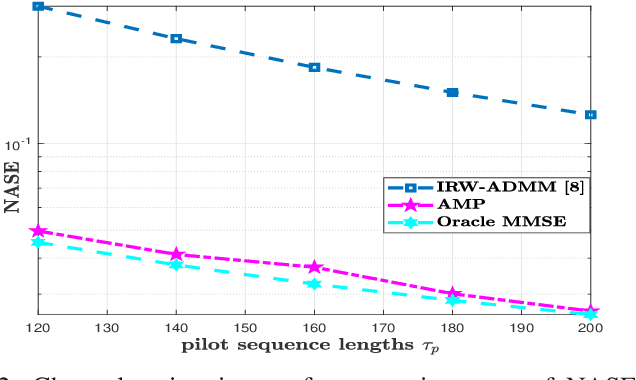
Abstract:This paper addresses the problem of joint user identification and channel estimation (JUICE) for grant-free access in massive machine-type communications (mMTC). We consider the JUICE under a spatially correlated fading channel model as that reflects the main characteristics of the practical multiple-input multiple-output channels. We formulate the JUICE as a sparse recovery problem in a multiple measurement vector setup and present a solution based on the approximate message passing (AMP) algorithm that takes into account the channel spatial correlation. Using the state evolution, we provide a detailed theoretical analysis on the activity detection performance of AMP-based JUICE by deriving closed-from expressions for the probabilities of miss detection and false alarm. The simulation experiments show that the performance predicted by the theoretical analysis matches the one obtained by the numerical results.
Spatial Correlation Aware Compressed Sensing for User Activity Detection and Channel Estimation in Massive MTC
Apr 17, 2021
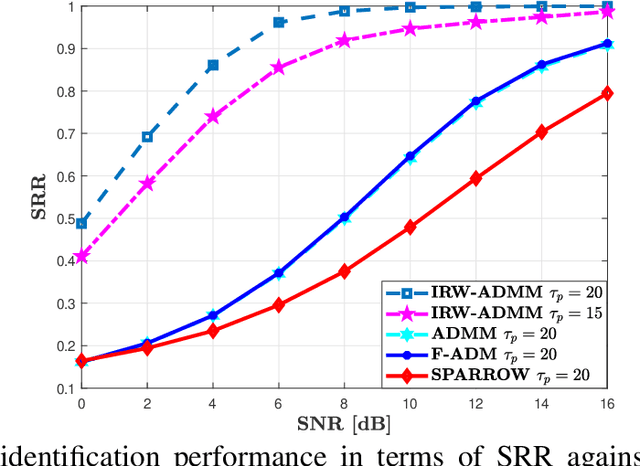
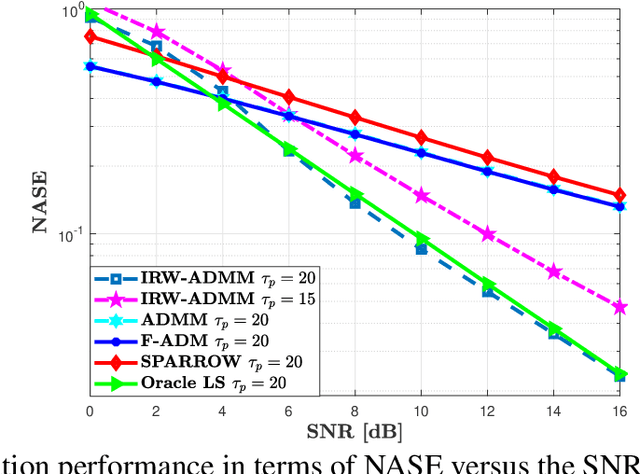
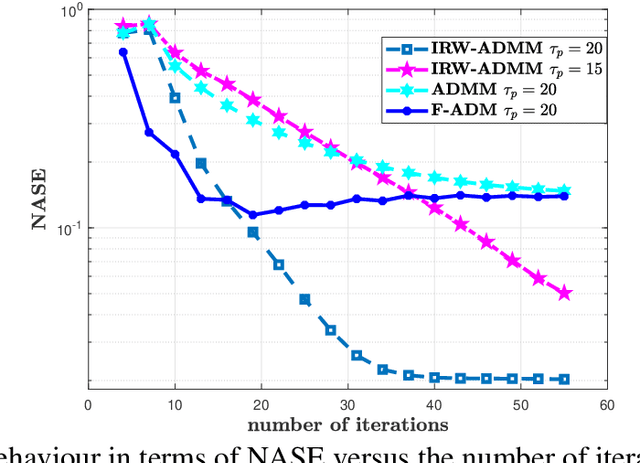
Abstract:Grant-free access is considered as a key enabler to massive machine-type communications (mMTC) as it promotes energy-efficiency and small signalling overhead. Due to the sporadic user activity in mMTC, joint user identification and channel estimation (JUICE) is a main challenge. This paper addresses the JUICE in single-cell mMTC with single-antenna users and a multi-antenna base station (BS) under spatially correlated fading channels. In particular, by leveraging the sporadic user activity, we solve the JUICE in a multi measurement vector compressed sensing (CS) framework under two different cases, with and without the knowledge of prior channel distribution information (CDI) at the BS. First, for the case without prior information, we formulate the JUICE as an iterative reweighted $\ell_{2,1}$-norm minimization problem. Second, when the CDI is known to the BS, we exploit the available information and formulate the JUICE from a Bayesian estimation perspective as a maximum \emph{a posteriori} probability (MAP) estimation problem. For both JUICE formulations, we derive efficient iterative solutions based on the alternating direction method of multipliers (ADMM). The numerical experiments show that the proposed solutions achieve higher channel estimation quality and activity detection accuracy with shorter pilot sequences compared to existing algorithms.
Iterative Reweighted Algorithms for Joint User Identification and Channel Estimation in Spatially Correlated Massive MTC
Mar 15, 2021
Abstract:Joint user identification and channel estimation (JUICE) is a main challenge in grant-free massive machine-type communications (mMTC). The sparse pattern in users' activity allows to solve the JUICE as a compressed sensing problem in a multiple measurement vector (MMV) setup. This paper addresses the JUICE under the practical spatially correlated fading channel. We formulate the JUICE as an iterative reweighted $\ell_{2,1}$-norm optimization. We develop a computationally efficient alternating direction method of multipliers (ADMM) approach to solve it. In particular, by leveraging the second-order statistics of the channels, we reformulate the JUICE problem to exploit the covariance information and we derive its ADMM-based solution. The simulation results highlight the significant improvements brought by the proposed approach in terms of channel estimation and activity detection performances.
 Add to Chrome
Add to Chrome Add to Firefox
Add to Firefox Add to Edge
Add to Edge